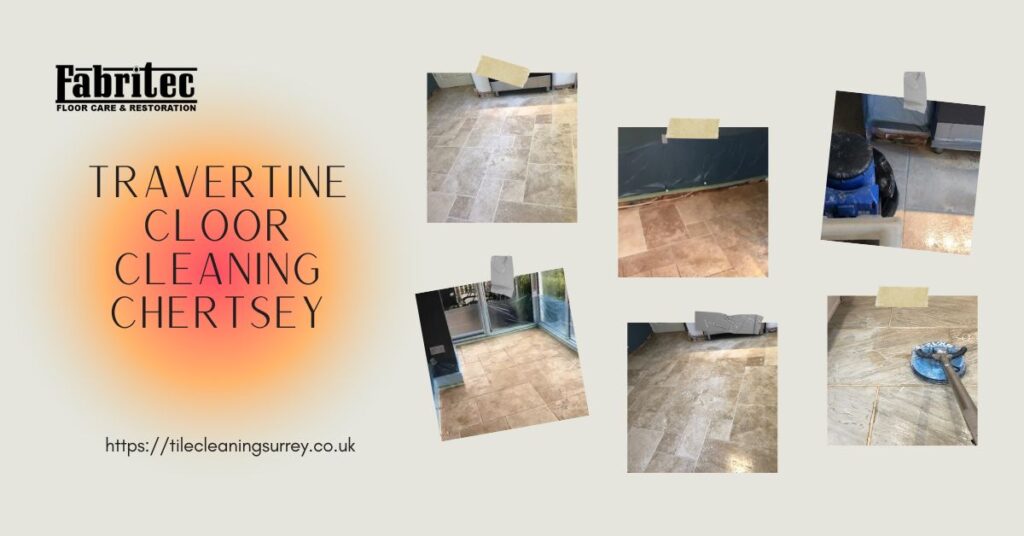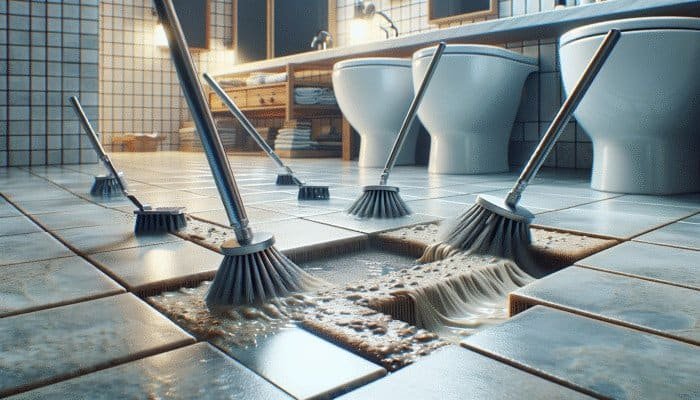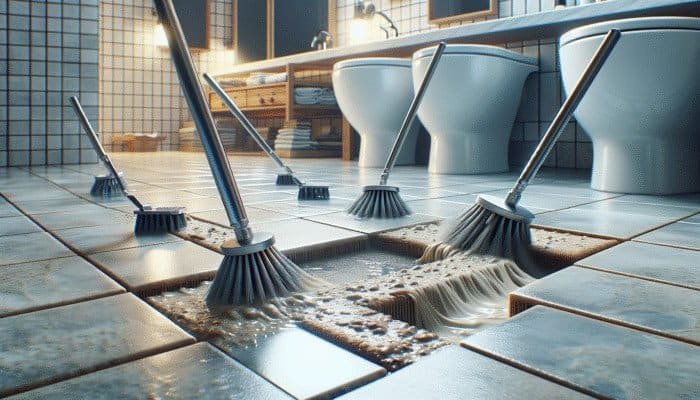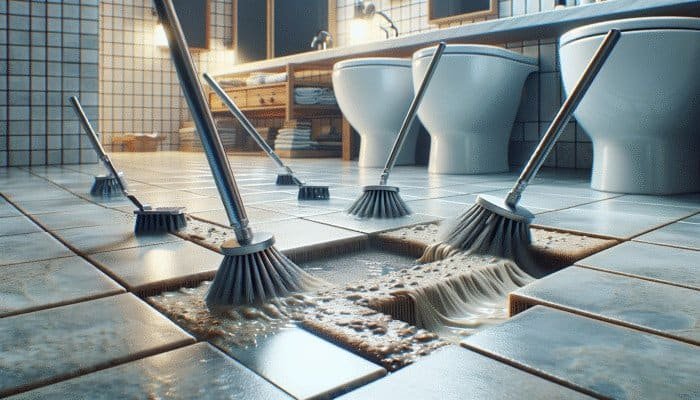
Master the Art of Caring for Your Exquisite Travertine Floors
Travertine floors are known for their breathtaking beauty and distinctive texture, which necessitates a dedicated and specialized maintenance routine to keep them looking pristine. In our recent project located in Chertsey, Surrey, we undertook the challenge of rejuvenating a heavily worn travertine floor within a residential environment. This comprehensive case study will guide you through the detailed techniques we implemented to clean, repair, and seal the travertine flooring effectively. Our thorough approach not only restored the floor to its original splendor but also significantly improved its durability, safeguarding it against future wear and damage. Regular travertine floor maintenance is crucial, as neglect can lead to serious deterioration over time, jeopardizing both the aesthetic appeal and structural integrity of your beautiful flooring.
Conducting In-Depth Assessments and Preparing Your Space for Optimal Cleaning
During our detailed initial assessment, we noted various signs of wear on the travertine floor, including significant dirt buildup in the grout lines and the characteristic small holes typical of travertine, as well as minor cracks in multiple tiles. To facilitate an efficient cleaning process, we meticulously removed all furniture from the area and conducted an extensive vacuuming to eradicate any loose debris and dust. This preparatory phase is vital for establishing a successful cleaning operation. Furthermore, we utilized protective sheeting to shield surrounding surfaces, including kitchen units and adjacent flooring. This precaution is essential to prevent potential damage from cleaning agents or equipment, thereby creating a safe and effective working environment. Implementing effective floor preparation techniques can greatly influence the overall success of the restoration process, ensuring optimal results and client satisfaction.
Executing a Comprehensive Deep Cleaning Strategy Tailored for Travertine Tiles
The foundation of revitalizing travertine lies in a rigorous deep cleaning regimen designed to tackle embedded dirt and stains. We commenced the process by applying a diluted, professional-grade travertine cleaner across the entire floor area, paying particular attention to the grout lines and heavily soiled sections. Allowing the cleaner to penetrate for approximately ten minutes is essential as it helps to effectively loosen entrenched dirt and grime. We then employed a rotary scrubbing machine to thoroughly work the cleaner into the tiles, successfully lifting the accumulated dirt and leaving the surface remarkably cleaner. To finalize the cleaning process, we conducted a pressure rinse, a critical step that eliminates any residual cleaning slurry and debris. This rinse also removes remnants of previous sealers, ensuring the surface is impeccably prepared for the subsequent repair and sealing stages. The significance of deep cleaning travertine cannot be overstated, as it lays the essential groundwork for a successful restoration and prolongs the floor's lifespan.
Utilizing Professional Repair Techniques to Effectively Restore Travertine Damage
Once the cleaning process was completed, we identified several natural holes and minor cracks within the travertine tiles, which are common challenges associated with this beautiful stone. To effectively address these issues, we implemented two specific repair strategies tailored to enhance the floor's integrity and appearance:
Expertly Filling Natural Holes to Enhance Visual Harmony:
We carefully used high-quality beige fillers that closely matched the existing tile color to fill the natural holes. This crucial step not only restored the floor's uniform appearance but also reduced the likelihood of future dirt accumulation within these crevices, thereby improving the overall aesthetic appeal. A well-executed filling process is vital for maintaining the integrity of travertine tiles and extending their lifespan, ensuring that the floor remains as beautiful as it is functional.
Advanced Techniques for Crack Repair to Ensure Longevity
For the cracked tiles, we chose a durable resin grout that accommodates slight movement without incurring additional cracking. By meticulously color-matching the grout to the tiles, we ensured that our repairs were virtually seamless, preserving the overall aesthetic of the floor. These expert repair techniques play a pivotal role in maintaining the beauty and functionality of travertine surfaces, ensuring they remain both attractive and resilient for years to come, providing homeowners with peace of mind.
Applying a Premium Quality Sealant to Enhance and Protect Your Travertine Floors
The final step in the restoration process involves applying a sealant to the travertine floor, which is crucial for ensuring long-lasting protection. The application of a sealant is essential for safeguarding the stone against stains, spills, and daily wear and tear, which significantly prolongs the lifespan of the floor. For this project, we selected a high-solids, breathable sealer that penetrates the travertine while providing a robust protective barrier on the surface. Our client chose a satin finish, which beautifully accentuates the natural elegance of the travertine without creating an overly glossy appearance. After applying the sealer, we allowed it to cure for several hours, ensuring that the floor was fully prepared for regular use and enjoyment. The significance of sealing travertine floors cannot be overstated, as it is a fundamental aspect of maintaining the beauty and integrity of the surface in the long term.
Establishing a Comprehensive Aftercare Strategy for Sustainable Beauty and Longevity
To maintain the refreshed and vibrant appearance of the travertine floor, we equipped our client with a thorough aftercare routine designed for regular implementation. This well-structured routine includes several essential practices that help protect the investment:
- Employ a pH-neutral cleaner specifically formulated for sealed natural stone, such as LTP Floorshine, to avoid damaging the protective seal.
- Consistently vacuum or dust the floor to eliminate dirt and debris that could potentially scratch the surface.
- Promptly address any spills to prevent staining and maintain the floor's immaculate condition.
- Reapply the sealer every 2 to 3 years, depending on foot traffic levels, to ensure the floor remains safeguarded and retains its aesthetic allure.
Maintaining a consistent aftercare routine is critical for ensuring the longevity and beauty of travertine flooring, enabling homeowners to enjoy their stunning floors for many years to come while preserving their value.
Experience the Incredible Transformation: The Benefits of Professional Restoration Services
After successfully completing the cleaning, repair, and sealing processes, the travertine floor at the Chertsey property experienced a breathtaking transformation. The floor now radiates a renewed luster, showcasing clean grout lines and nearly invisible repaired cracks. The client expressed immense satisfaction with the outcome, and the floor is now well-protected against potential future damage, ensuring its beauty endures for many years ahead. This project serves as a testament to the effectiveness of professional maintenance in preserving both the aesthetic appeal and functional longevity of travertine flooring. A delighted client remarked, “We couldn’t be happier with the results! Our travertine floor looks absolutely stunning—like it’s brand new again. The team was professional, thorough, and took great care to restore every detail. We’re thrilled with how well the repairs blend in, and the sealing has made cleaning so much easier. Highly recommend their service!”
Your Essential Questions About Travertine Floor Care Answered
What is the Recommended Cleaning Frequency for My Travertine Tiles?
To effectively maintain travertine tiles, regular cleaning is essential, ideally once or twice a week, depending on foot traffic levels in your home. Additionally, conducting a thorough deep cleaning every six months is advisable to ensure that the tiles retain their aesthetic appeal and longevity. Always choose appropriate cleaners specifically designed for travertine to safeguard your investment in this flooring. The frequency of travertine tile cleaning is crucial for preserving its enduring beauty and structural integrity, preventing the buildup of grime and dirt.
Is Vinegar Safe for Cleaning Travertine Surfaces?
Using vinegar on travertine surfaces is highly discouraged, as its acidic properties can inflict damage on the stone and its protective seal. It is far more beneficial to utilize a pH-balanced cleaner specifically formulated for natural stone, which will help maintain the integrity and longevity of your travertine flooring. Understanding which products to avoid is essential for travertine surface preservation and ensuring that the floors remain in excellent condition for years to come.
What Are the Common Indicators of Damage to Travertine?
Common signs of travertine damage include visible cracks, chips, discoloration, and uneven surfaces. Persistent stains or a dull appearance may also indicate wear, which necessitates immediate attention to maintain both the aesthetics and structural integrity of the flooring. Recognizing these signs early can facilitate timely intervention, ensuring the durability of travertine floors and preserving their beauty for the long haul, ultimately saving you time and money on repairs.
Is Travertine Appropriate for Outdoor Applications?
Yes, travertine is highly suitable for outdoor applications due to its durability and natural slip resistance. However, proper sealing is essential to protect it from the elements and staining, ensuring its longevity while maintaining its visual appeal in outdoor environments. Understanding the suitability of travertine for outdoor environments can assist homeowners in making informed decisions regarding their outdoor spaces, ensuring both safety and aesthetic harmony.
What Steps Can I Take to Prevent Future Staining on Travertine?
To effectively prevent future staining on travertine, it is crucial to regularly apply a high-quality sealer, promptly clean up spills, and use pH-neutral cleaners. Additionally, maintaining a consistent cleaning routine will enhance the stone's durability and visual appeal. Proactive measures are key to ensuring the long-term beauty of travertine surfaces and protecting your investment in this stunning flooring, allowing you to enjoy its natural beauty without worry.
The post: Travertine Cleaning Chertsey was produced by Travertine Floor Cleaning Chertsey
The Article Cleaning and Sealing a Travertine Floor in Chertsey, Surrey appeared first on https://fabritec.org
The Article Travertine Floor Cleaning and Sealing in Chertsey Was Found On https://limitsofstrategy.com
The Article Travertine Floor Cleaning and Sealing Services in Chertsey First Appeared ON
: https://ad4sc.com












Sergio Reed
Ah, travertine floors! The unsung heroes of interior design—beautiful, timeless, and about as high-maintenance as a prima donna in a Broadway musical. I must say, I’ve always admired those patterns that resemble nature’s own artistry, but boy, do they come with their own set of challenges!